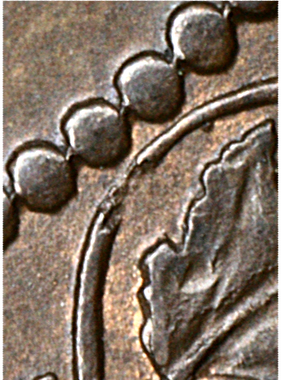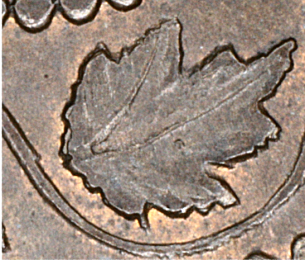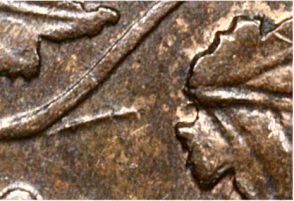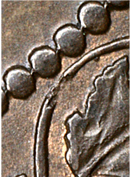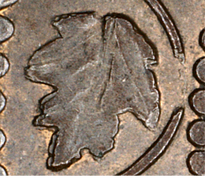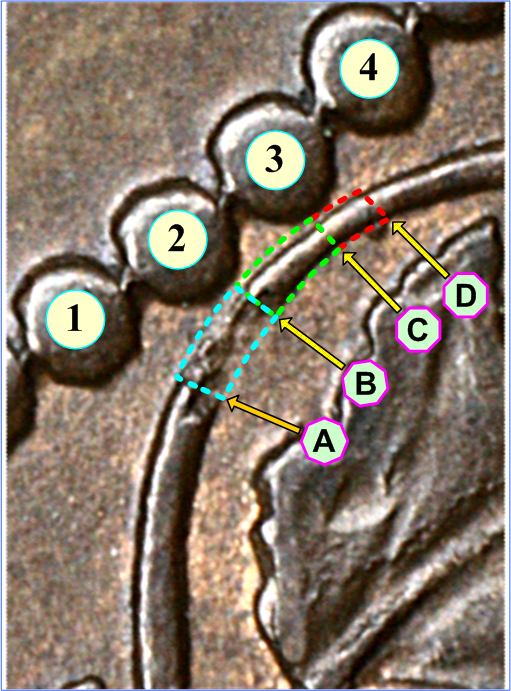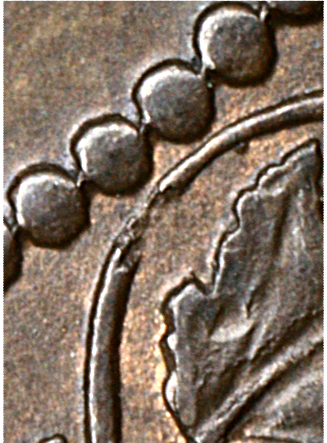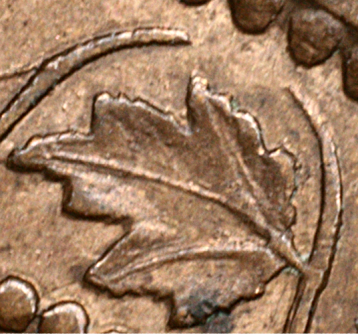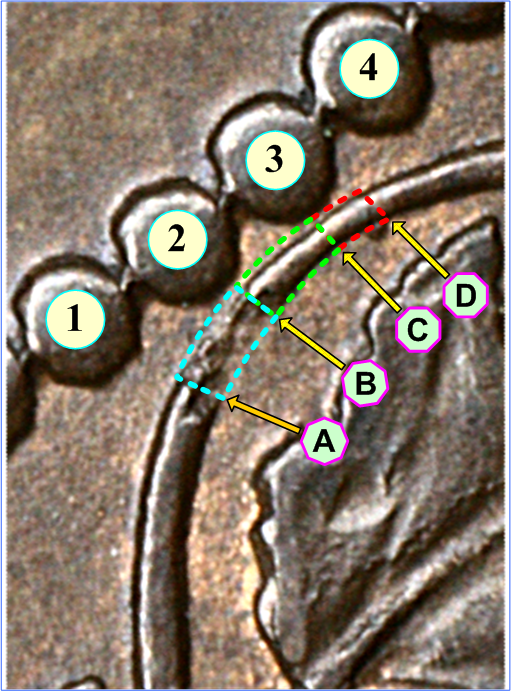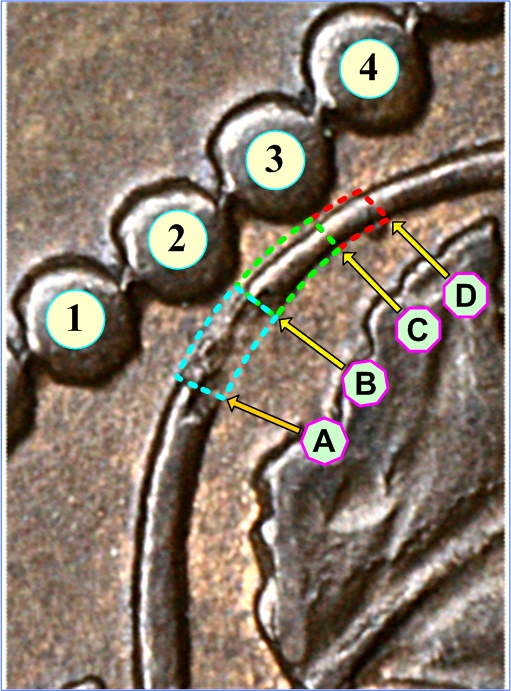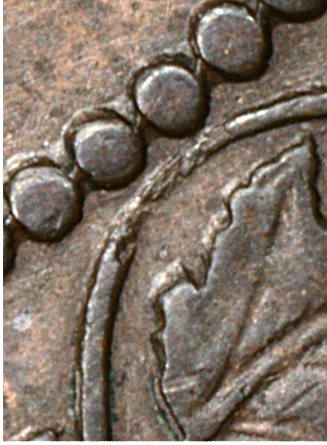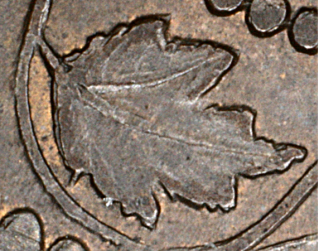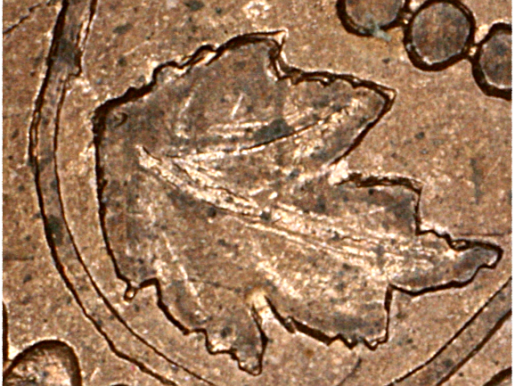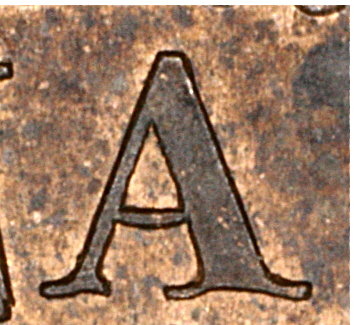SECTION THREE
PUNCH PROBLEMS
Staging the Reverse Punch
Within the first few dies sunk, parts of the legend and date, as well as certain portions of the maple wreath began to shear off the reverse punch. These defects could not be repaired (at least on the punch itself), so each new piece that broke off caused a new defect to be passed on to all subsequent dies produced from that punch.
It is quite useful to follow the developing changes in the reverse punch. These changes can be described in terms of Punch States. With each successive piece lost a new punch state was formed. During the production of the 66 reverse dies used for the 1858 and 1859/8 cents (May 27 to October 2, 1858), the reverse punch progressed from State 1 (fully intact) to State 6. Then, probably in October, 1858, the Royal Mint made its only deliberate modification to the reverse punch during the period of the Provincial coinage: the final 8 of the date was ground off, making the partial date, 185-. This was in preparation for sinking dies for the upcoming continuation of the cent coinage in 1859. That action converted the punch to State 7, the first state from which what would become the 1859 Narrow 9 dies were sunk. From then on the 9 of the date had to be added to each die by hand. The 9 punch(es) employed bore a much narrower figure (Narrow 9) than the special Wide 9 used to overdate some of the 1858 dies for use in 1859.
Up until June of 1859, when the last Provincial cent reverse dies were sunk, we have assigned a total of 13 states to the reverse punch: States 1-6 sank 1858 dies and States 7-13 sank dies dated 185-. The key areas of deterioration in the maple wreath were Stems 6, 8, 9 & 10 and Vine Loops 2, 7 & 13. Except for Loop 7, each part that broke off the punch appears to have done so instantaneously. That is, the part was there one moment and missing the next, leaving no dies showing intermediate stages.
Loop 7 was the one area where the loss of detail was gradual or incremental. By the time punch State 7 (the state when the first 185- dies were sunk) was reached, a Narrow gap (see illustration below) had already formed. Its formation involved two intermediate states. But, once developed, the Narrow gap was stable for some time. It persisted for the rest of the 1858 dies and through about the first 133 of the 185- dies sunk.
Then followed a gradual change in the gap from Narrow to a conformation called Wide, from which it did not change again. The transition involved the right-hand vine section only; the left-hand section was essentially stable. It consumed no more than about 20 dies. For simplicity any transitional Loop 7 gap between Narrow and Wide will be called a Medium gap, the four versions of which will be called Medium 1, Medium 2, Medium 3, and Medium 4. To aid in understanding the transitional process a Narrow gap photo is shown on which the beads in the adjacent inner circle are numbered and lettered lines divide the area of change in the right-hand vine into three sections: a-b, b-c, c-d. When we look in detail at the reverse punch states below, we’ll see how each Loop 7 Medium gap conformation is transformed into the next and finally into the Wide gap.
It is quite useful to follow the developing changes in the reverse punch. These changes can be described in terms of Punch States. With each successive piece lost a new punch state was formed. During the production of the 66 reverse dies used for the 1858 and 1859/8 cents (May 27 to October 2, 1858), the reverse punch progressed from State 1 (fully intact) to State 6. Then, probably in October, 1858, the Royal Mint made its only deliberate modification to the reverse punch during the period of the Provincial coinage: the final 8 of the date was ground off, making the partial date, 185-. This was in preparation for sinking dies for the upcoming continuation of the cent coinage in 1859. That action converted the punch to State 7, the first state from which what would become the 1859 Narrow 9 dies were sunk. From then on the 9 of the date had to be added to each die by hand. The 9 punch(es) employed bore a much narrower figure (Narrow 9) than the special Wide 9 used to overdate some of the 1858 dies for use in 1859.
Up until June of 1859, when the last Provincial cent reverse dies were sunk, we have assigned a total of 13 states to the reverse punch: States 1-6 sank 1858 dies and States 7-13 sank dies dated 185-. The key areas of deterioration in the maple wreath were Stems 6, 8, 9 & 10 and Vine Loops 2, 7 & 13. Except for Loop 7, each part that broke off the punch appears to have done so instantaneously. That is, the part was there one moment and missing the next, leaving no dies showing intermediate stages.
Loop 7 was the one area where the loss of detail was gradual or incremental. By the time punch State 7 (the state when the first 185- dies were sunk) was reached, a Narrow gap (see illustration below) had already formed. Its formation involved two intermediate states. But, once developed, the Narrow gap was stable for some time. It persisted for the rest of the 1858 dies and through about the first 133 of the 185- dies sunk.
Then followed a gradual change in the gap from Narrow to a conformation called Wide, from which it did not change again. The transition involved the right-hand vine section only; the left-hand section was essentially stable. It consumed no more than about 20 dies. For simplicity any transitional Loop 7 gap between Narrow and Wide will be called a Medium gap, the four versions of which will be called Medium 1, Medium 2, Medium 3, and Medium 4. To aid in understanding the transitional process a Narrow gap photo is shown on which the beads in the adjacent inner circle are numbered and lettered lines divide the area of change in the right-hand vine into three sections: a-b, b-c, c-d. When we look in detail at the reverse punch states below, we’ll see how each Loop 7 Medium gap conformation is transformed into the next and finally into the Wide gap.
|
Narrow:
Wide: |
The right end of the gap (point b) falls at about the center of bead 2 in the inner circle. Both ends of the gap terminate in a jagged, diagonal edge that widens toward the bottom. The gap (section a-b) is about the width of one bead.
The right end of the gap falls at point d (near the right edge of bead 3), and it is more even than it was previously (when at point b). The bottom of the gap is about 2 & ½ beads wide, consisting of a slightly raised area. |
We’re now ready to look in detail at each state of the reverse punch that sank the 185- dies. Each state will be summarized at the left via a column of abbreviations indicating the condition of the various sites that were either already deteriorated or would later deteriorate to form other states (see table below). For each of the seven states following State 7 the change(s) that had occurred to cause the punch to progress from the previous state to the current state are highlighted in red.
Punch State 7
On reverse punch State 7, the first state of the 185- reverse punch, we illustrate three of the four critical stems were already broken (see top row of photos). Only Stem 10 retained its original conformation. Of the critical vine loops, Loop 2 was in its original state, Loop 7 was in the Narrow gap conformation (The right end of the gap (point b) falls at about the center of bead 2 in the inner circle. Both ends of the gap terminate in a jagged, diagonal edge that widens toward the bottom. The gap is about the width of one bead.), and Loop 13 had a Wide gap. The broken Loop 13 is of minor importance, as it never changed. State 7 is the most stable of all the states, lasting for some 133 dies.
Punch State 8
At about die 134 the reverse punch lost a sliver along the top of Loop 7 section b-c (The remaining bottom edge is usually, but not always, at full relief.), creating the Medium 1 gap. This state (State 8) was the most stable of the four different Medium gap conformations, lasting for about ten dies
Punch State 9
At about die 144 two things occurred on the reverse punch to form State 9. The gap in Loop 7 changed to Medium 2 (The remaining sliver along the bottom of b-c has broken off, so c-d is now similar to section a-b: a roughened area rising barely above the surrounding field. Section c-d has narrowed, but is in full relief.); and it lost a wide section of Loop 2. This state lasted for about six dies.
Punch State 10
At about die 150 the gap in Vine Loop 7 changed again: very thin sliver broke off along the top edge of section c-d and the bottom portion of c-d now slopes down toward the gap. This state (State 10) was very transient, lasting for only about three dies.
Punch State 11
At about die 154 the reverse punch lost more of the lower sliver in Loop 7 section c-d, leaving its upper surface less sloped than previously and closer to the surrounding field, forming Loop 7 gap Medium 4. State 11 was very transient, lasting for only about three dies.
Punch State 12
At about die 158 Loop 7 made its last change to create the Wide gap. The remaining “extra” metal in vine section c-d was lost, leaving an abrupt termination of the right-hand vine section at point d (lines up near the right-hand edge of bead 3). The entire bottom of the gap, which is about 2 & ½ beads wide, is a slightly raised area of about the same height. This state (State 12) was quite stable, lasting for some 95 dies.
Punch State 13
At about 185- die 249 the final change occurred in the reverse punch when Stem 10 broke off. From this point on the punch appears to have remained stable. The total output of reverse punch State 13 was about 87 dies, although it is believed 39 of them were not used and were ultimately destroyed. This reduced the effective output to about 48 dies.
Deterioration of the Obverse Punch
On the obverse the Queen’s portrait remained intact, but the letters of the legend gradually degraded. Many letters ultimately broke, but we get only a small glimpse of how they appeared to the Mint staff when the dies were freshly sunk. That is because the defective letters were almost always repaired during the process of die finishing. On six dies, though, the broken A of REGINA was not repaired and coins from those dies show us the A with its missing right serif on the base of its left leg (just as it must have appeared on the defective obverse punch that sank the dies).

